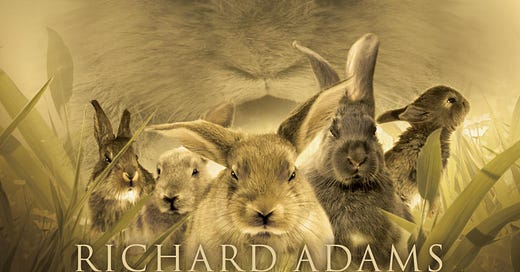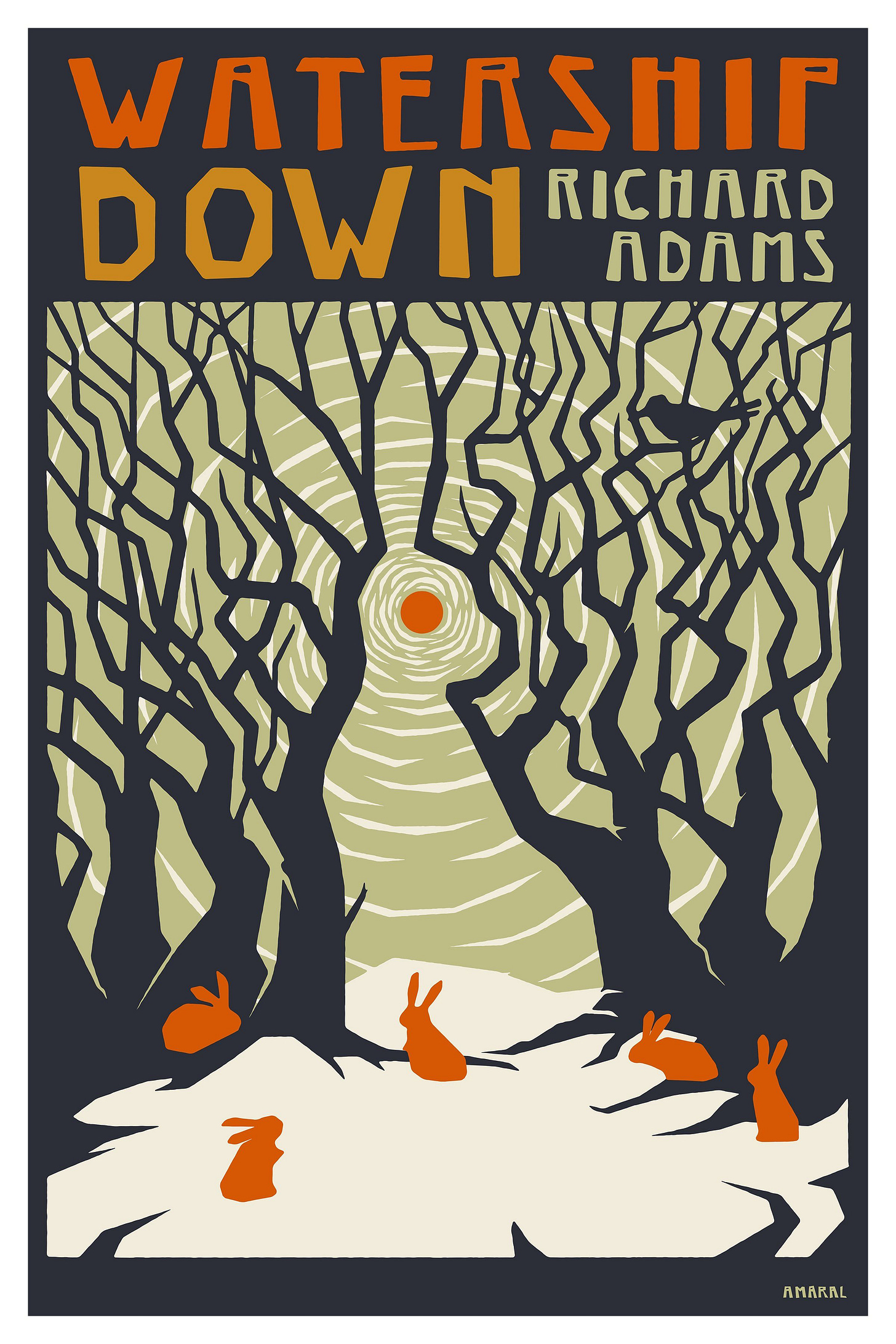Your Next Read: Watership Down (Review)
Let me be upfront: my plan is to convince you to read Watership Down. You'll thank me for it later.
I myself did not read Watership Down until I was 45.
Though it had been enthusiastically recommended to me many, many times, like so many other novels, there it sat on my “SOMEDAY” shelf. For years. For decades. Then, at age 45, I finally got around to Richard Adams’ 1972 classic–and oh how I regret delaying so long. The book is fantastic.
Don’t you make my mistake. Read it soon. Today, even. And here are three reasons you should.
The Wonder of Rabbits
If you’ve not yet been introduced to Watership Down, please allow me.
First and foremost, know it’s about rabbits. Talking rabbits. No, they don’t wear clothes or drive cars like Disney movies (or Redwall): Adams’ rabbits are not merely humans in long eared, fluffy-tailed fur suits. They run on all fours, live in burrows, and eat grass. Zoological details about rabbit social groups, physiology, and habits abound. For example, in one instance a rabbit uses a board like a raft to cross a river; the others simply cannot comprehend how their eyes are witnessing a rabbit actually floating on the water. Their brains aren’t wired that way.
For all its realism, though, the rabbits are anthropomorphized. They speak. They have names, like Strawberry, Hazel, Pipkin, and Bigwig. They hope and fear, and they dream. Adams describes their warrens akin to structured human societies, led by a “chief” or a “general.” They have jobs, like police and guards. They sing songs, recite poetry, and tell stories.
Further–and one of the highlights of the book–they have a language. In “Lapine,” automobiles are called hrududu, a delightful onomatopoeia based on the rumble of the engine. Elil are “rabbit enemies,” including both natural predators (foxes, stoats, etc.) and also humans. In Lapine are only numbers one, two, three, and four; rabbits don’t have the capacity to count any higher. Any number above four is simply hrair: many (or a thousand).
One of my favorite parts of the novel is rabbit mythology. Interwoven throughout the book are folktales about the progenitor rabbit of myth, El-ahrairah, the great trickster. Origin stories are told explaining why rabbits run fast, dig, and have fluffy tails. And short lives. Ultimately, these “tall tales” take on a delightfully parallel life of their own that greatly enhances the novel’s main plot. (If you worldbuild, you could learn a lot from this. I did.)
Finally, understand there is really no “magic” in the book, per se. While it is a fantasy, it lies much closer to a novelization of a fairy story–an epic one. One sensitive little rabbit (Fiver) does dream in premonitions, but there are no wizards nor witches, no spells nor monsters. Adams’ fantastical tropes are created by “other-izing” the natural world, by putting we readers in an utterly foreign perspective—a rabbit’s. And the way he creates wonder from that cannot be overstated. From beginning to end, the book “feels” enchanted.
A Classic Story Made New
You will love these rabbits and their quest.
As in most novels, a reader’s emotion sprouts from strong characterization–relatable characters doing understandable things in pursuit of a goal they (and we readers) care about. Here, each rabbit has a distinct personality, and many experience profound character arcs. Campbell’s Hero’s Journey is overt, for both individuals and the warren as a whole. Thresholds to adventure are crossed and many transformations occur. Hazel, smart and caring, gains confidence as a leader. Bigwig (my personal favorite) is huge, simple, but becomes fiercely loyal. We care deeply for these characters because they’re so well drawn, with flaws, strengths, wants, and needs. Even the later-half’s antagonist, the brutal General Woundwart, for as much as we despise him, is given motivations: we see why he lusts for control, and see the chance he has to redeem himself. (Spoiler: he doesn’t.)
Many have commented that Watership Down is a retelling of the Aeneid, Virgl’s story of a hero fleeing the fall of Troy and ultimately adventuring his way into the founding of Rome. Once you learn that, you can’t unsee it. It’s obvious throughout the novel. Fleeing from the violent destruction of their warren. Striking out into a dark, mysterious world in search of a new home. The many perils–including all-out war–to establish a new, better home. This is a classic motif transformed to the micro level of rabbits, dogs, birds, and mice. And it gels with our collective subconscious:
"By basing his story on one of the most popular books of the Middle Ages and Renaissance, Adams taps into a very old myth: the flight from disaster, the heroic refugee in search of a new home, a story that was already over a thousand years old when Virgil told it in 19 BC." (John Rateliff)
Like our ancestors, we root for “heroic refugees” as they navigate a dangerous landscape. We worry about them. Some die along the way, and it’s heartbreaking. But in the end, we applaud their hard-won accomplishments, the return to normalcy. Adams’ reimagining of a classic fits perfectly, containing all the excitement and emotional punch we readers could ask for. Does it matter these are rabbits, rather than ancient Greeks or modern men? Not in the least. In fact, I’d argue it works even better, as rabbits are more vulnerable. They have “a thousand enemies,” everywhere, and only their wiles and their speed to protect them. They are true “underdogs”--and we pray they’ll defy the odds, somehow, and succeed. (Spoiler: they do.)
Deep, Timeless Themes
Finally, let’s spend a moment on the novel’s meaning.
If you, like me, enjoy “meaty” themes in fiction, Watership Down is a butcher-shop full of them. If not, if you just love a well-told plot, a fun read, then you can just ignore theme. The book satisfies on both the surface and the deeper levels. It works on the beach as well as the classroom.
I won’t turn this into an analysis–that’s not my intention here–but I will say the themes are at once timeless and fresh. Freedom and self-determination are obvious pick-outs, as our rabbits do not bow to authority, even when the risk is great. They learn, seek, and find their own way, fighting together to create a new warren better than any they’ve known before. They avoid the polar extremes of cowering to tyranny (Efrafa) and of mindless self-indulgence (the Warren of the Snares) to found a society based on reason, on the common good. As a proud American–a man of the West–I couldn’t ask for a more meaningful goal to strive for. Or to read about.
The other aspect I’d like to briefly mention concerns religion. Now, in interviews Adams pretty clearly poo-poo’s this, as well as any other such deeper readings. He said Watership Down was…
"only a made-up story... in no sense an allegory or parable or any kind of political myth. I simply wrote down a story I told to my little girls."
But, like Tolkien and many other authors who’ve said similar things, does the author’s intention actually matter? Adams clearly promotes the values of early 20th century England–including Christianity. At the very least in sensibility and allusion.
While modeled on folk tales, the figure of El-ahrairah is rife with religious significance. And we’ve not yet mentioned his counterpart, the Black Rabbit of Inlé–feared but necessary, the ghostly embodiment of death itself. And above all, sits Lord Firth, creator of the world, who delves out justice and watches over his flock (of rabbits–and all other creatures in addition).
(Spoiler alert here…) In the novel’s epilogue, it thus feels only right when Hazel, our protagonist, old and tired, earns his Heavenly reward. The leader is visited by El-ahrairah and led to a better place:
“You’ve been feeling tired,” said the stranger, “but I can do something about that. I’ve come to ask you whether you’d care to join my Owsla [warren]. We shall be glad to have you and you’ll enjoy it. If you’re ready, we might go along now.”
They went out […] The sun was shining […] It seemed to Hazel that he would not be needing his body any more, so he left it lying on the edge of the ditch […]
He reached the top of the bank in a single, powerful leap. Hazel followed; and together they slipped away, running easily down through the wood, where the first primroses were beginning to bloom.
Beautiful, isn’t it? Much ink could be spent on the deep religious undertones of the novel–as well as much else besides.
But let’s stop here, so you can go read this wonderful book.
Thanks for reading! I’m always interested in your thoughts.









Would be excited to receive such an excellent copy of this book!
I wholeheartedly second this recommendation, which I’ve always thought of as Lord of the Rings with rabbits instead of hobbits, but a lapine retelling of Virgil’s Aeneid is an even better characterization. My only quibble would be with the editorial translation of “Owsla” as “warren”: a more accurate translation would be “royal guard”, I think. On that note, one of my favourite features of the book is how it gradually and gently introduces us to the rabbit language so that the climactic (sort-of spoiler alert) “Silflay hakra u embleer hrair!” makes perfect sense to us: it’s the best use of an alternate language to swear (or at least be inspiringly crudely insulting) in a children’s book that I’ve ever seen!